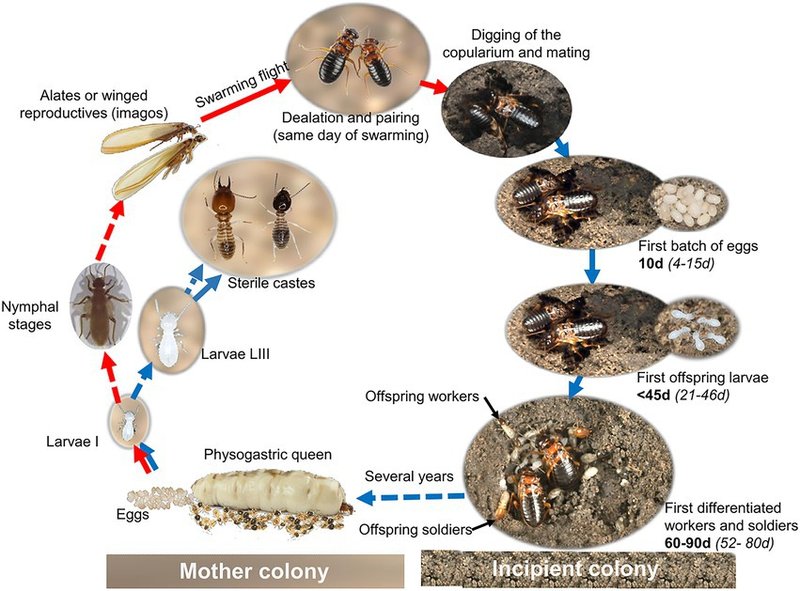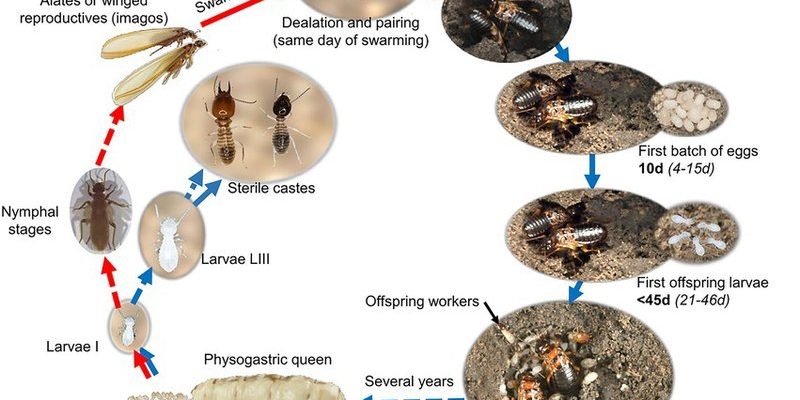
The journey of the termite is like an intricate tapestry woven with threads of environmental change, survival strategies, and, believe it or not, social structure. Just like a family with unique roles, termites have developed a complex society that makes them not just survivors but also essential players in their ecosystems. You might be wondering, how did these tiny insects go from simple wood-eaters to the diverse and complex creatures we see today? Let’s unpack that together.
The Origins of Termites
Termites belong to the order Blattodea, which also includes cockroaches. The earliest ancestors of termites appeared roughly 300 million years ago during the Carboniferous period. Back then, long before they evolved into the wood-chomping insects we know, their ancestors were likely scavengers, feasting on decaying plant material. Think of them as the pioneers of decomposition, helping to break down organic matter.
Over time, some of these cockroach-like ancestors began adapting to consume wood—a much more complex food source. This change might seem simple, but it was big game as it let termites thrive in a world where plant matter was abundant. Fast-forward a bit, and by the Late Cretaceous period, around 100 million years ago, true termites emerged. This was a game-changer for the ecosystem, as they started playing crucial roles in nutrient cycling and soil health.
Interestingly, termites’ ability to digest cellulose—a major component of plant cell walls—comes from the microbes living in their guts. These symbiotic relationships are pivotal. Just like how we rely on gut bacteria to break down food, termites depend on their gut microbes to handle tough materials like wood. It’s a mutually beneficial relationship that has stood the test of time.
The Evolution of Social Structures
One of the most captivating aspects of termites is their social structure. They’re among the few insects that exhibit a highly organized colony lifestyle. Imagine a bustling city where everyone has a specific job. Termite colonies can have millions of individuals, consisting of workers, soldiers, and reproductive members (the king and queen). Each caste plays a crucial role in maintaining the colony’s health and productivity.
The worker termites are the real heroes; they build and repair the nest, gather food, and care for the young. Without them, the whole colony would struggle to survive. Soldiers, on the other hand, are the defenders of the colony. With their strong jaws, they protect against predators like ants and spiders. Finally, the king and queen focus on reproducing and ensuring the colony continues to thrive.
This caste system is a remarkable evolutionary adaptation. It allows termites to be efficient and effective in their environment. You could think of it as nature’s version of a well-oiled machine, where every part plays a role in the larger function. It’s not just about survival; it’s about thriving through collaboration.
Termites and their Ecosystem Role
Termites are often labeled pests, but they play a crucial role in their ecosystems. They’re nature’s recyclers, breaking down dead wood and plant matter, returning nutrients to the soil, and promoting plant health. By doing this, they help maintain the balance of the ecosystems they inhabit.
Without termites, forests would become overrun with decaying plant material. This buildup can lead to nutrient depletion in the soil, which, in turn, affects plant growth. Think of them as the unsung heroes of the forest floor, silently doing their part to keep everything healthy. Their tunneling activities also aerate the soil, improving water infiltration and availability for plants.
In many regions, termites are crucial for maintaining biodiversity. By enabling new plants to grow, they help create habitats for countless other species. This interdependence illustrates how every element in an ecosystem is connected, each playing its part for a thriving environment.
Termites Through the Ages
As the planet evolved, so did termites. Over millions of years, they adapted to various climates and landscapes. This adaptability is part of what makes them so successful. Whether in rainforests, savannas, or deserts, termites have found ways to thrive.
In the warmer, wetter climates, we see larger colonies and species with more complex social systems. For instance, the African driver termite builds towering mounds that can reach over 10 feet high, showcasing incredible building skills. In contrast, termites living in drier regions tend to be smaller and have adapted to store resources more efficiently, ensuring their survival in harsher conditions.
Interestingly, leaf-cutting termites have developed a unique approach to food sourcing. They cut leaves to cultivate fungus, which they then eat. This impressive feat showcases their evolutionary journey, highlighting how they can adapt to different food sources while further enhancing their colony life.
Human Interaction with Termites
As our ancestors began to build homes and create agriculture, termites presented new challenges. Unfortunately, they took a keen interest in wooden structures, leading to damage and financial losses. It’s no surprise that many people despise these critters, viewing them solely as pests. However, understanding their history gives us a more nuanced perspective.
Instead of viewing them as just a nuisance, we can see termites as an essential part of our ecosystems. In many cultures, they’ve been respected for their contributions. For instance, in some communities, they’re even harvested for food, prized for their protein content. In the grand scheme of things, the more we understand about the evolution and role of termites, the better equipped we are to manage their presence.
There are many ways to minimize termite damage, like using treated wood in construction or regular inspections of your home. But if we can appreciate their place in the natural world, it may lead to stronger strategies for coexisting.
The Future of Termites
With climate change and habitat destruction, the future of termites is uncertain. As their environments change, how will they adapt? Some species are already showing resilience to shifts in weather and availability of resources. Understanding their adaptability can provide insight into ecosystems’ overall health.
Research into termite behavior and ecology continues to evolve. Scientists are studying how their roles in carbon cycling can impact climate change. With termites playing a significant role in breaking down organic materials, they may help mitigate some effects of environmental change.
Adapting our approach to termites can also mean learning from them. Their cooperative behaviors can inspire new ways of thinking about community and collaboration in human societies. As we learn more about them, we can better appreciate the intricate relationships that sustain life on our planet.
In closing, the journey of termites is a remarkable story of evolution, adaptation, and interdependence. From their origins millions of years ago to their vital roles in modern ecosystems, termites remind us of the interconnectedness of all living things. By understanding their history, we can appreciate these creatures for their immense contributions—both to nature and to us. So next time you encounter a termite, remember that there’s a whole world of history and evolution behind that tiny insect.

